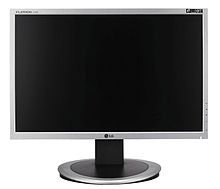Widescreen monitor
A widescreen monitor is a screen in widescreen format . Widescreen television screens and computer screens have an aspect ratio of 16: 9. The 16:10 aspect ratio is less common on computer monitors.
Ultrawide are monitors with an aspect ratio of 21: 9. They are mainly used for computer games and as an alternative to two screens side by side. The first devices came on the market in 2014.
Size information
The size of a monitor refers to the screen diagonal, which is usually given in inches . It is only partially comparable for different formats. For example, a conventional 4: 3 monitor with the same screen diagonal has 6% less width, but 13% more height and a total of 7% more area than a monitor in 16:10 format.
Compared to a 4: 3 screen with 15.0 (12.0 × 9.0) inches, in 16:10 format you get the same width at 14.2 (12.0 × 7.5) inches, the same Height at 17.0 (14.4 × 9.0) inches and the same area at 15.5 (13.1 × 8.2) inches.
Advantages and disadvantages
For books or documents such as letters, a layout in portrait format is usually used because the flow of reading decreases as the width of the text increases. With small diagonals, screens in 4: 3 format have a clear advantage, as they are better suited for display due to their height.
With widescreen monitors with a diagonal of 22 inches (55 centimeters) or more, two A4 pages can be displayed next to each other on a 1: 1 scale on the screen, so that a pivot function for rotating the monitor by 90 degrees is no longer required to obtain a portrait format image surface.
